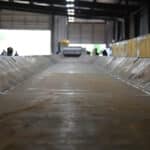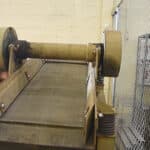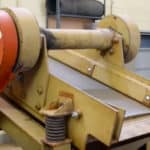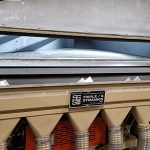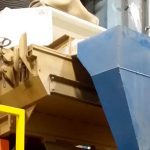Glossary of Terms
Accumulation Conveyor
This storage conveyor is simply a horizontal discharge bin with no mechanisms or moving parts in the food zone. This feature offers quick and thorough clean-out for enhanced sanitation and a greatly reduced risk of cross contamination between product runs.
Bed
The pan or bed where the material being conveyed is held, slides or moves across while in movement down the conveying line.
Bed Length
The length measurement of the pan.
Bed Width
The width measurement of the pan.
Belt
The belt can be made of several materials such as cotton or PVC. It is placed around atleast two pulleys to create a continuous motion to carry materials.
Belt Speed
Is measured in Feet Per Minute (FPM). A section of belt that moves past a fixed point within a given point in time.
Blinded
When the openings of a screen are closed, either by plastering with damp sticky material or by wedging of on-size particles in the opening.
Bulk Density (lb/ft3 or kg/m3)
Most people are familiar with Bulk Density because it is used to determine effective capacities for storage bins and containers. It is also fundamental to the structural design of these vessels. This parameter is defined as the mass of a granular material that will occupy a specific volume, such as a bin or railcar. Bulk density includes not only particle mass but also the air entrained in the void spaces between the particles.
Actually, there are two unique types of bulk density that are important: Packed Bulk Density and Aerated Bulk Density. Aerated Bulk Density, also known as Loose Bulk Density, is the easiest to measure and is determined by pouring a quantity of granular material into a container of known volume. This is representative of the bulk solid that has not been subjected to compression or packing. Packed Bulk Density, on the other hand, is the bulk density of the material after it has been compressed, and thus the entrained air has been displaced. This is representative of the material’s actual bulk density in storage and transport, and is a more realistic quantity to use.
Compressibility (%)
Some granular materials have a propensity to become tightly packed; others do not. After determining Aerated and Packed Bulk Densities, the Compressibility of a material can be calculated as: C stands for Compressibility (%), BDP is the Packed Bulk Density, and BDA is the Aerated Bulk Density. This parameter provides an indication of particle size, shape, uniformity and cohesion, and thus the overall flowability of the material. Bulk solids with a Compressibility less than approximately 18 percent are considered free flowing.
Dispersibility (%)
Dispersibility is a measure of the propensity for a granular material to form dust and thus lose mass to the surrounding air. It is especially important during vertical flow (e.g., pile formation after spout or conveyor discharge). The more dispersible a material, the higher the potential for mass loss due to dust generation.
Diverter
A diverter moves materials to a different point or section of the conveying process. Can be used to sort, accumulate or merge material.
Drive
The mechanism that gives the conveyor power.
Gate
A gate opens and material is moved to a different point or section of the conveying process. Can be used to sort, accumulate or merge material.
HZ
A unit of electrical frequency. Usually a unit of frequency is equal to one cycle per second.
Overhead Drive
A drive that is installed over a conveyor.
Scalping
Separation of part of the total feed as coarse oversize by retention on openings (round, square or slotted) more than half again as large in diameter or width as the largest particle in undersize.
Screen Efficiency
The percentage of the true undersize in the feed that actually passes through the screen openings.
Screening
Removing part of the total feed as a fine fraction passing through the screen openings.
Sizing
Separating a particulate material into three or more fractions.
Uniformity (unitless)
The relative homogeneity of the size and shape of the particles within a bulk solid (i.e., uniformity) has a direct effect on a material’s ability to flow. This can be quantified by determining the screen size that will allow 60 percent of a sample to pass through (which is generally a relatively large mesh size) and the screen size that will allow 10 percent to pass through (which is generally a relatively small mesh size). Uniformity is then calculated by dividing the 60 percent mesh size by the 10 percent mesh size. Thus, the smaller the uniformity value, the more homogeneous the particle sizes and shapes. A material that is more uniform will have a tendency to have better flowability than a material with a wide range of particle sizes.
Variable Speed
A drive that can change speeds.

